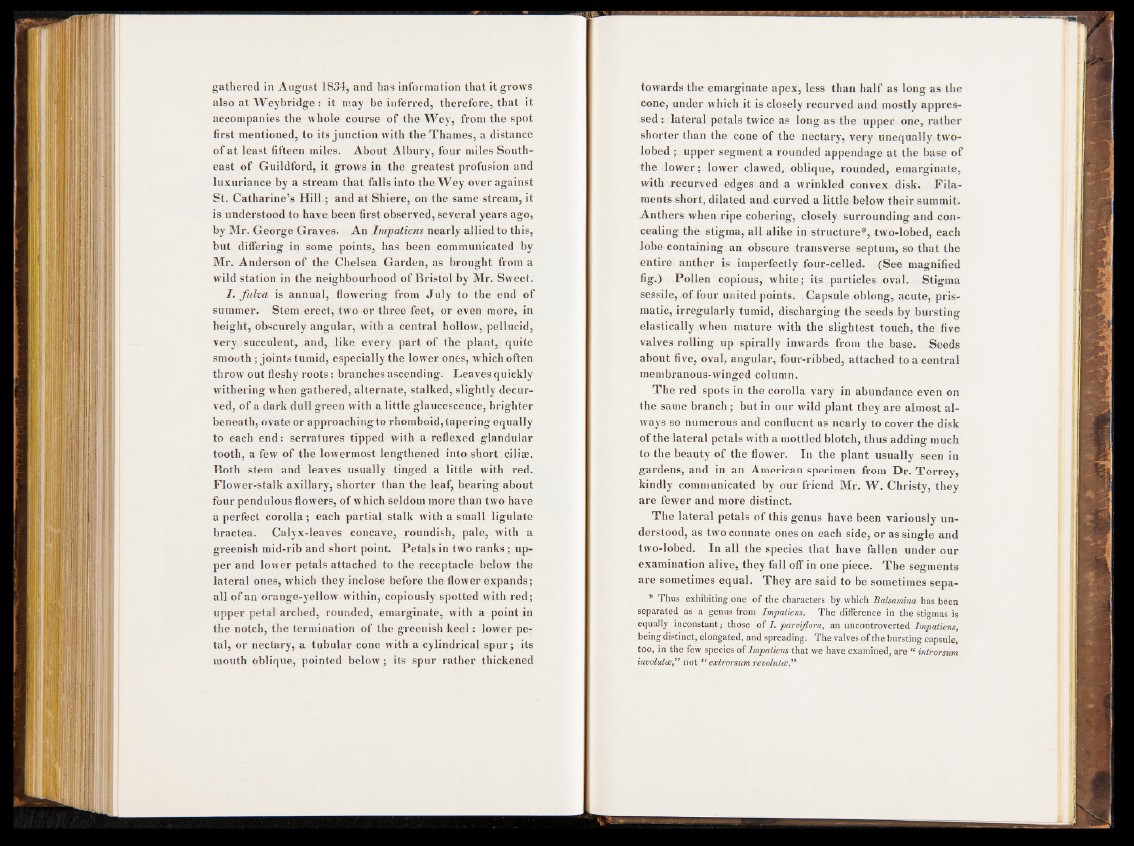
gathered in August 1834, and has information that it grows
also at Weybridge: it may be inferred, therefore, that it
accompanies the whole course of the Wey, from the spot
first mentioned, to its junction with the Thames, a distance
of at least fifteen miles. About Albury, four miles Southeast
of Guildford, it grows in the greatest profusion and
luxuriance by a stream that falls into the Wey over against
St. Catharine’s Hill ; and at Shiere, on the same stream, it
is understood to have been first observed, several years ago,
by Mr. George Graves. An Impatiens nearly allied to this,
but differing in some points, has been communicated by
Mr. Anderson of the Chelsea Garden, as brought from a
wild station in the neighbourhood of Bristol by Mr. Sweet.
I. fulva is annual, flowering from July to the end of
summer. Stem erect, two or three feet, or even more, in
height, obscurely angular, with a central hollow, pellucid,
very, succulent, and, like every part of the plant, quite
smooth; joints tumid, especially the lower ones, which often
throw out fleshy roots: branches ascending. Leaves quickly
withering when gathered, alternate, stalked, slightly decur-
ved, of a dark dull green with a little glaucescence, brighter
beneath, ovate or approachingto rhomboid, tapering equally
to each end: serratures tipped with a reflexed glandular
tooth, a few of the lowermost lengthened into short ciliffi.
Both stem and leaves usually tinged a little with red.
Flower-stalk axillary, shorter than the leaf, bearing about
four pendulous flowers, of which seldom more than two have
a perfect corolla; each partial stalk with a small ligulate
bractea. Calyx-leaves concave, roundish, pale, with a
greenish mid-rib and short point. Petals in two ranks; upper
and lower petals attached to the receptacle below the
lateral ones, which they inclose before the flower expands;
all of an orange-yellow within, copiously spotted with red;
upper petal arched, rounded, emarginate, with a point in
the notch, the termination of the greenish keel; lower petal,
or nectary, a tubular cone with a cylindrical spur; its
mouth oblique, pointed below; its spur rather thickened
towards the emarginate apex, less than half as long as the
cone, under which it is closely recurved and mostly appres-
sed : lateral petals twice as long as the upper one, rather
shorter than the cone of the nectary, very unequally two-
lobed upper segment a rounded appendage at the base of
the-lower; lower clawed, oblique, rounded, emarginate,
with recurved edges and a wrinkled convex disk. Filaments
short, dilated and curved a little below their summit.
Anthers when ripe cohering, closely surrounding and concealing
the stigma, all alike in structure*, t.wo-lobed, each
Jobe containing an obscure transverse septum, so that the
entire anther is imperfectly four-celled. (See magnified
fig.) Pollen copious, white; its particles oval. Stigma
sessile,,of four united points, .Capsule oblong, acute, prismatic,
irregularly tumid, discharging the seeds by bursting
elastically when mature with the slightest touch, the five
valves rolling up spirally inwards from the base. Seeds
about five, oval, angular, four-ribbed, attached to a central
membranous-winged column.
The red spots in the corolla vary in abundance even on
the same branch ; but in our wild plant they are almost always
so numerous and confluent as nearly to cover the disk
of the lateral petals with a mottled blotch, thus adding much
to the beauty of the flower. In the plant usually seen in
gardens, and in an American specimen from Dr. Torrey,
kindly communicated by our friend Mr. W. Christy, they
are fewer and more distinct.
The lateral petals of this genus have been variously understood,
as two connate ones on each side, or as single and
two-lobed. In all the species that have fallen under our
examination alive, they fall off in one piece. The segments
are sometimes equal. They are said to be sometimes sepa-
* Thus exhibiting one of the characters by which Balsamina has been
separated as a genus from Impatiens. The difference in the stigmas is
equally inconstant; those of I. parviflora, an uncontroverted Impatiens,
being distinct, elongated, and spreading. The valves of the bursting capsule,
too, in the few species of Impatiens that we have examined, are “ introrsum
involutes,” not “ extrorsum revolutcB."